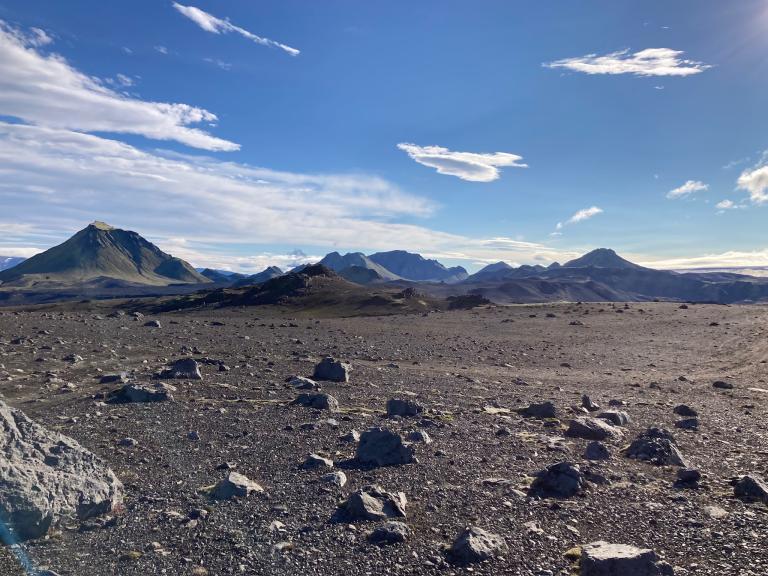
Lead supervisor: Helen Williams, Earth Science
Co-supervisor: Simon Matthews, Institute of Earth Sciences, University of Iceland; Oliver Shorttle, Earth Sciences
Brief summary:
Can we use new isotopic tracers to identify stranded core material in the Iceland plume?
Importance of the area of research concerned:
Primitive magmas erupted on ocean islands have long been used to probe the geochemistry of the Earth’s mantle. Recent studies have demonstrated that the Iceland plume contains a component of ‘primordial’ lower mantle material that may record evidence of interaction with the Earth’s metallic core formed in the first ~ 45 Myr of the Earth’s history (1). It is also possible that some of the isotopic and elemental signatures ascribed to the presence of stranded core material could be generated by other processes, such as the incorporation of metal associated with residual crystal cumulates formed when Earth had a magma ocean (2) or the presence of residual sulfide exsolved from the Earth’s mantle in the aftermath of the Moon-forming giant impact (3). Distinguishing between these scenarios is essential to understanding the origin and preservation of primordial material in the Earth’s mantle, which remains unresolved despite its importance for the solid Earth’s evolution. Interactions between silicate-sulfide-metal phases are important for the distribution of economically important precious metals like gold and platinum in the Earth’s interior and surface.
Project summary :
A challenge of the OIB ‘core component’ model is that tungsten isotopes, a widely used tracer of core material, do not correlate with other siderophile (iron-loving) and chalcophile (sulfur-loving) elements considered to be present at high levels in the core. One explanation for this may be the retention of siderophile and chalcophile elements in mantle sulfide, whereas lithophile (silicate-loving) tungsten is concentrated in the melt. Alternatively, these primordial signatures may not reflect core material, but instead other lower mantle components such as crystal cumulates or exsolved sulfide liquid left over from magma ocean crystallisation. These different models will be tested using novel siderophile and chalcophile stable isotope measurements in well characterised suites of primitive basalts from Iceland where isotopic evidence for primordial material has already been documented.
What will the student do?:
The student will study primitive Icelandic basalt samples that preserve variable contributions of a primordial component, as indicated by their tungsten and other isotope systems. The student will select samples (from existing collections or sampled during a field campaign) based on their isotope geochemistry and petrology for chalcophile-siderophile element (e.g., copper, zinc etc.,) stable isotope analysis. Stable isotope data will be collected using plasma source mass spectrometry (multiple-collector inductively-coupled plasma mass spectrometry; MC-ICPMS) at Cambridge, potentially using a state of the art collision-reaction cell (CRC) MC-ICPMS instrument (ThermoFisher ‘Neoma’) installed in 2023. This new data will be compared with quantitative geochemical predictions obtained from the application and development of new numerical models for magmatic processes in the upper and lower mantle developed in our earlier work (2).
References - references should provide further reading about the project:
Mundl-Petermeier, A., Walker, R.J., Jackson, M.G., Blichert-Toft, J., Kurz, M.D. and Halldórsson, S.A., 2019. Temporal evolution of primordial tungsten-182 and 3He/4He signatures in the Iceland mantle plume. Chemical Geology, 525, pp.245-259.
Williams, H.M., Matthews, S., Rizo, H. and Shorttle, O., 2021. Iron isotopes trace primordial magma ocean cumulates melting in Earth’s upper mantle. Science Advances, 7(11), p.eabc7394.
Savage, Paul S., F. Moynier, H. Chen, G. Shofner, J. Siebert, J. Badro, and I. S. Puchtel. "Copper isotope evidence for large-scale sulphide fractionation during Earth’s differentiation." Geochemical Perspectives Letters (2015).
Applying
You can find out about applying for this project on the Department of Earth Sciences page.